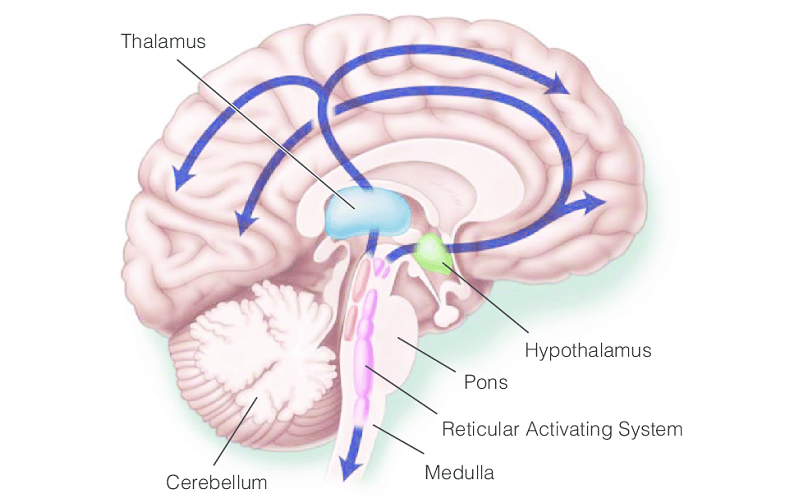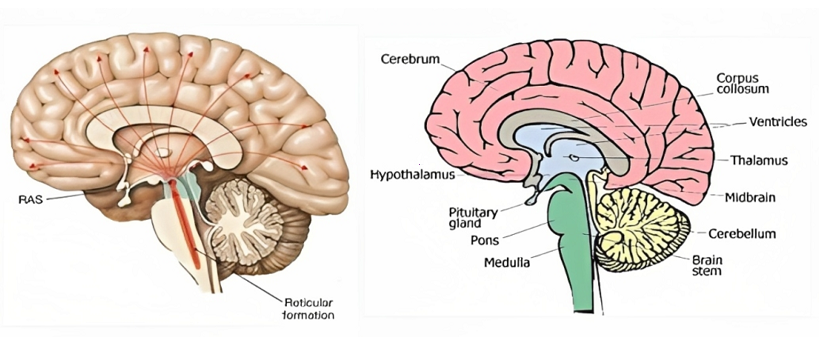
Nestled within the brainstem, the intricate network of neurons called the Reticular Formation plays a pivotal role in regulating our sleep patterns and maintaining alertness, acting as a silent conductor orchestrating the symphony of our conscious and unconscious states. Despite its relatively obscure presence in the grand scheme of brain anatomy, the reticular formation is a cornerstone in understanding how our brains function in daily life. From dictating the delicate balance between sleep and wakefulness to influencing our ability to focus and stay alert, this part of our brain is integral to our overall cognitive health and well-being.
Contents
Anatomy of the Reticular Formation
The reticular formation, a pivotal yet often overlooked structure within the brainstem, serves as a critical hub in our neural network. Its intricate anatomy is not just a marvel of biological engineering but also a key to understanding its multifaceted roles in brain function.
Location and Structure of the Reticular Formation
Nestled within the core of the brainstem, the reticular formation is strategically positioned between the medulla, pons, and midbrain. This central location is crucial, as it allows the reticular formation to interact seamlessly with various parts of the central nervous system. Structurally, it is composed of a complex network of neurons, which are intermingled with a variety of nerve fibers. This intricate meshwork gives it a somewhat ‘reticular’ (net-like) appearance, hence its name.
The neurons within the reticular formation are unique in their diversity. They vary significantly in size, shape, and neurochemical characteristics. This diversity is essential for the wide range of functions the reticular formation performs, from processing sensory information to regulating vital autonomic functions.
Connection of the Reticular Formation to Other Brain Parts
The reticular formation’s central location in the brainstem places it in an ideal position to communicate with multiple regions of the brain. It sends projections to the cerebral cortex, thalamus, hypothalamus, and spinal cord, establishing it as a critical relay station in the brain.
One of its key connections is with the thalamus, acting as a filter for the sensory information that is relayed to the cerebral cortex. This filtering mechanism is vital for prioritizing which stimuli require immediate attention and which can be relegated to the background. Additionally, its connections to the spinal cord are crucial for modulating motor control and reflexive actions.
The reticular formation also has extensive links with the limbic system, particularly the hypothalamus, which plays a significant role in autonomic and endocrine control. This connection underlines its involvement in emotional responses and stress regulation.
Through these intricate connections, the reticular formation acts as a central hub, integrating sensory and cortical information, and playing a pivotal role in maintaining overall brain function and homeostasis [1].

Functions of the Reticular Formation
The reticular formation, though modest in size, performs a myriad of essential functions that are crucial for our daily living. Its roles range from regulating the sleep-wake cycle to modulating sensory information and maintaining alertness.
Reticular Formation and the Regulation of the Sleep-Wake Cycle
One of the most vital functions of the reticular formation is its role in the regulation of the sleep-wake cycle. It acts as a master switch, controlling the transition between wakefulness and sleep. This regulation is achieved through a complex interplay of neuronal networks that either stimulate or inhibit various parts of the brain.
During the wakeful state, the reticular formation activates the cerebral cortex, keeping the brain alert and responsive. Conversely, during sleep, it facilitates the deactivation of the cortex, allowing for rest and recovery. This transition is not just about turning ‘on’ or ‘off’; it involves a fine-tuned balance that ensures a smooth flow between different stages of sleep, including the deep REM (Rapid Eye Movement) stage where dreaming occurs.
The Reticular Formation’s Role in Maintaining Alertness and Consciousness
Apart from its crucial role in sleep regulation, the reticular formation is also key in maintaining alertness and consciousness. It constantly processes sensory information from the environment and the body, filtering out unnecessary noise and focusing attention on significant stimuli. This selective attention mechanism is essential for cognitive functions like learning, memory, and decision-making [2].
The reticular activating system (RAS), a component of the reticular formation, is particularly significant in this context. The RAS influences the brain’s state of wakefulness and alertness. It ensures that the brain is ready to respond appropriately to stimuli, particularly those that require immediate attention or action.
Reticular Formation Modulation of Sensory Signals
Another critical function of the reticular formation is the modulation of sensory signals. It acts as a gatekeeper, determining which sensory inputs are important enough to reach the conscious level of the brain. This process is vital for preventing sensory overload, which can occur if the brain were to process every single sensory input it receives.
By filtering sensory information, the reticular formation helps in focusing attention and aids in the smooth execution of motor responses. This modulation is not just limited to external stimuli but also includes internal cues from within the body, playing a role in the regulation of autonomic functions like heart rate, breathing, and blood pressure.
Through these diverse functions, the reticular formation proves to be an indispensable component of the brain, intricately involved in various aspects of our cognitive and physiological functioning.

The Reticular Formation and Sleep
The intricate relationship between the reticular formation and sleep is a fascinating area of study in neuroscience. Here we examine how the reticular formation plays a critical role in sleep induction and maintenance, its interaction with various sleep-related hormones and neurotransmitters, and its impact on sleep quality and disorders.
The Reticular Formation’s Mechanism of Sleep Induction
The mechanism by which the reticular formation induces sleep is a complex interplay of neural circuits and chemical signals. During wakefulness, the reticular activating system (RAS), a part of the reticular formation, keeps the brain alert by sending continuous signals to the cerebral cortex. As we transition to sleep, these signals diminish, leading to a state of decreased arousal and consciousness [3].
Neurons in the reticular formation release inhibitory neurotransmitters like GABA (gamma-Aminobutyric acid), which help reduce the activity of the brain’s arousal centers. This process is crucial in initiating the first stage of sleep, moving from wakefulness to light sleep, and subsequently into deeper stages of non-REM (Rapid Eye Movement) sleep.
How the Reticular Formation Interacts with Sleep Hormones and Neurotransmitters
The reticular formation’s role in sleep is closely linked to various hormones and neurotransmitters that regulate sleep-wake cycles. One such crucial neurotransmitter is serotonin, which is involved in mood regulation and sleep. The reticular formation contains serotonergic neurons that modulate sleep patterns.
Melatonin, the hormone produced by the pineal gland, also interacts with the reticular formation. Melatonin levels increase in the evening, signaling the body that it is time to sleep. The reticular formation responds to these increased levels by aiding the onset of sleep.
Additionally, the reticular formation interacts with other neurotransmitters like norepinephrine and dopamine, which have roles in both promoting wakefulness and modulating sleep stages. The balance and interaction of these chemicals are essential for maintaining a healthy sleep cycle.
The Reticular Formation’s Impact on Sleep Quality and Disorders
The reticular formation’s dysfunction can lead to various sleep disorders. Conditions like insomnia, sleep apnea, and restless leg syndrome can have links to anomalies in the reticular formation’s functioning. For instance, an overactive reticular formation can lead to difficulties in falling or staying asleep, characteristic of insomnia [4].
Conversely, damage to the reticular formation can result in excessive sleepiness and disorders such as narcolepsy. Understanding the role of the reticular formation in these disorders is crucial for developing effective treatments and therapies.
Research continues to unravel the complexities of the reticular formation’s involvement in sleep regulation. This understanding not only provides insights into the fundamental mechanisms of sleep but also opens avenues for addressing various sleep-related disorders, ultimately contributing to better overall health and well-being.
The Reticular Formation in Maintaining Alertness
The role of the reticular formation extends beyond regulating sleep; it is equally vital in maintaining alertness and consciousness. Here we look at the neurological mechanisms behind this function, the influence of the reticular formation on attention and cognitive functions, and its involvement in disorders related to alertness dysregulation.
The Reticular Formation’s Neurological Mechanisms for Alertness
The reticular formation is central to the brain’s arousal system, which is responsible for maintaining a state of alertness and readiness to respond to stimuli. The reticular activating system (RAS), a key component of the reticular formation, plays a pivotal role in this process. The RAS sends continuous impulses to the cerebral cortex, the area of the brain responsible for thought, perception, and voluntary movement. These impulses keep the cortex active and alert.
This state of alertness is maintained by a balance of excitatory and inhibitory signals within the brain. Neurotransmitters like acetylcholine, norepinephrine, and serotonin, which are modulated by the reticular formation, play a significant role in this balancing act. These chemicals ensure that the brain remains in a state of readiness, able to quickly and efficiently process and respond to external and internal stimuli [5].
Influence of the Reticular Formation on Attention and Cognitive Functions
The reticular formation’s impact on alertness directly influences our attention and overall cognitive functions. By regulating the flow of sensory information to the brain and filtering out irrelevant stimuli, the reticular formation enables us to focus and concentrate on tasks at hand. This selective attention is essential for learning, memory formation, and problem-solving.
Furthermore, the reticular formation contributes to the regulation of mood and emotion. Its connections with the limbic system, the part of the brain that controls emotions, allow it to play a role in emotional responses and stress management. This connection underscores the importance of the reticular formation in both cognitive and emotional aspects of our daily lives.
Reticular Formation Disorders Related to Alertness Dysregulation
Disturbances in the function of the reticular formation can lead to various disorders related to alertness and attention. Conditions such as Attention Deficit Hyperactivity Disorder (ADHD) and certain forms of depression may be linked to dysregulation in the areas of the brain involving the reticular formation.
Additionally, neurological disorders like Parkinson’s disease and Alzheimer’s disease, which affect cognitive functions, may have associations with changes in the reticular formation’s structure and function. Understanding these connections is critical for developing more effective treatments and management strategies for such conditions.
References
[1] Reticular Activating System
[2] The Neurobiology of Sleep
[3] Sleep Neurobiology from a Clinical Perspective
[4] Control of Sleep and Wakefulness
[5] Neural Circuitry of Wakefulness and Sleep

